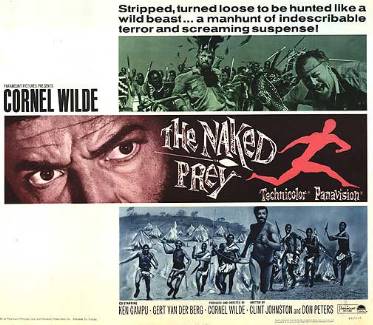- The Naked Prey
Infobox_Film
name = The Naked Prey
 | caption =
| caption =
writer = Clint Johnston
Don Peters
starring =Cornel Wilde Ken Gampu Patrick Mynhardt
Bella Randels
director =Cornel Wilde
producer =Cornel Wilde
Sven Persson
distributor = Paramount
released =14 June 1966
runtime = 96 mins.
language = English,Afrikaans ,Nguni languages
amg_id = 1:34402
imdb_id =
budget ="The Naked Prey" (1966) is a
adventure film starringCornel Wilde , who also directed and produced. It was released byParamount Pictures .Set in the
South African veldt , the film is awilderness survival story loosely based on the experiences of an explorer,John Colter , who was pursued byBlackfoot warriors through frontierWyoming in 1809.The screenplay earned Clint Johnson and Don Peters an Academy Award nomination.
Plot summary
Wilde, whose character is never named, plays a professional guide leading a white man (Gert Van der Berg) and his friends on an elephant hunt through the African
veldt during the colonial era. When the group intrudes on a local tribe's territory, some natives politely accost them, expecting to be bought off with gifts. Although the guide advises his client to be courteous, warning "they could give us a bad time", he insults the natives and sends them away empty-handed. Later, the tribe returns en masse, captures the entire party, and puts the captives to death, using variouscruel and unusual methods. One man is covered in clay and roasted alive on a spit; another is tarred, feathered, and trussed, then chased and killed by all the women. The man who insulted the tribesmen is trapped in a ring of fire with a poisonous snake.Wilde's character is spared until the last. He is stripped naked and given a brief head start, then chased by some of the tribesmen. With a combination of luck, cunning, and desperation, he eludes the warriors, killing several; finds food and water; and, after many days, dashes into a fort just seconds ahead of his pursuers. As he reaches safety, the man turns and exchanges a salute with their leader (Ken Gampu). Five of the 10 pursuers were cast together in "Diamond Walkers" (1965).
Although the story is violent, there are a few scenes of tenderness and humour after the man is rescued from drowning by an African girl, who travels with him for a day or two. As they walk along, he sings a 19th-century drinking song, "Little Brown Jug" and the child sings a song in her own language; they then attempt to sing each other's songs.
The soundtrack consists of African tribal chants, natural sounds, and occasional dialog, in English and otherwise. There are no subtitles; incidental music is also mostly absent.
Production and critical reception
"The Naked Prey" was filmed on location in southern Africa. The initial version was set in the American West and more closely resembled the incident that inspired it; however, financial concerns persuaded Wilde to change the setting to Africa.
Wilde was an athlete; he qualified for the Olympics as a fencer in 1936. However, he was nearing fifty years old when the movie was shot. He was also sick during much of the filming, but pressed on, saying the illness added to his performance.
The minimal dialog, richly realized African settings, and emphasis on making "the chase (and violent combat along the way) a subject unto itself, rather than the climax to a conventional story" [Brode, Douglas. "Boys and Toys: Ultimate Action-Adventure Movies". Citadel Press, 2003, p. 186.] distinguish "Naked Prey" as an innovative and influential adventure film. [Brode, ibid.] However, although it is considered a small classic today ["Naked Prey is Wilde's Minor Classic", "The State", October 20, 1989, p. 4D] , it received mixed reviews at the time of its release. Robert Alden of the "
New York Times ", reacting to the brutality of some of the early scenes, dismissed the film as "poor and tasteless motion-picture entertainment", but did acknowledge its "authentic African setting" and "effective use of tribal drums and native music." [Alden, Robert "Screen: 'The Naked Prey':Cornel Wilde Is Chased Through the Jungles", "The New York Times ", June 15, 1966]Roger Ebert , taking a different tack, called "Naked Prey" "pure fantasy" of the "great white hunter " variety, adding disdainfully: "Sure, it's nice to think you could outrun half a dozen hand-picked African warriors simply because you'd been to college and readThoreau , but the truth is they'd nail you before you got across the river and into the trees." [Ebert, Roger "The Naked Prey", "The Chicago Sun-Times ", June 14, 1967.]Other reviewers, however, were more enthusiastic. In "Time", the film was described as "a classic, single-minded epic of survival with no time out for fainthearted blondes or false heroics" where "natives are not the usual faceless blacks but human beings whose capacity for violence the hero quickly matches." ["Man Hunt" (review). "Time", June 17, 1966.] ; while the "Variety" reviewer praised the documentary-style use of nature photography to show "the pattern of repose, pursuit, sudden death and then repose" that characterises the entire chase. ["The Naked Prey" (excerpt of 1966 review), "Variety" ( [http://www.variety.com/review/VE1117793408.html?categoryid=31&cs=1&p=0 (full text)] ] .
"The Naked Prey" was released on DVD by
The Criterion Collection in January 2008.The film's soundtrack has been available on CD from
Locust Music since 2005; it features Nguni tribal songs specifically recorded for the film. [Crumshaw, Michael. "Review of Cornel Wilde's "The Naked Prey" (soundtrack)." "Dusted Magazine", June 13, 2005 [http://www.dustedmagazine.com/reviews/2201 (full text)] ]In popular culture
As teenagers, Joel and Ethan Coen shot their own version of "The Naked Prey" on a Super-8 camera. They called it "Zeimers in Zambia" and cast a neighbor, Mark Zimering, in the lead role. ["Gods of Film-making", "Joel and Ethan Coen" [http://www.ambidextrouspics.com/html/joel_and_ethan_coen.html (full text)] ]
External links
*imdb title|id=0060736
* [http://movies2.nytimes.com/gst/movies/movie.html?v_id=34402 "The Naked Prey"] in the "New York Times All Movie Guide."ee also
*"Zulu"
*"The Most Dangerous Game "
*"Apocalypto "References
Wikimedia Foundation. 2010.
